1993 PONTIAC BONNEVILLE change wheel
[x] Cancel search: change wheelPage 74 of 322

Tilt Steering Wheel
A tilt steering wheel allows you to
adjust the steering wheel before you
drive. You can
also raise it to the highest
level to give your legs more room when
you
exit and enter the vehicle.
To tilt the wheel, hold the steering
wheel and
pull the lever. Move the
steering wheel to a comfortable level,
then release the lever
to lock the wheel
in place.
Power Windows
Switches on the driver’s armrest control
each
of the windows when the ignition
is
on. In addition, each passenger door
has a control switch for its own window.
When the driver’s window switch is
held rearward for more than a half
second, the window will lower
completely. The window can be opened
in smaller amounts by pressing the
switch rearward and releasing it
immediately.
To stop the window while it is lowering,
press the switch again, then release.
To
raise the window, hold the switch
forward.
r
Turn SignallHeadlight
Beam Lever
The lever on the left side of the steering
column includes your:
Headlight High-Low Beam
Headlight Washers
Windshield Wipers
Windshield Washer
0 Cruise Control (Option)
Turn Signal and Lane Change
The High-Low Beam feature is
discussed under
Headlights. See the
Index under Headlights.
(SSE and SSEi only)
Indicator
73 ==.
t ProCarManuals.com
Page 78 of 322

Headlight Washers (opT1oN)
If you have this option, you can wash
your headlights
in bad weather or
whenever desired. Here’s how:
To operate the headlight washers, the
ignition must be on. Pull the paddle on
the turn signal/headlight beam lever
labeled
PULL. Each headlight will get
a spray
of washer fluid.
H Cruise Control (OPTION)
With cruise control, you can maintain a
speed of about
25 mph (40 h/h) or
more without keeping your foot on the
accelerator. This can really help
on long
trips.
Cruise control does not work at speeds
1
below about 25 mph (40 km/h).
When you apply your brakes, the cruise
control shuts
off.
Cruise control can be
- b dangerous where you can’t
drive safely at a steady speed.
So, don’t use your cruise control
on winding roads or in heavy
traffic.
,Cruise control can be dangerous
on slippery roads. On such
roads, fast changes in tire
traction can cause needless wheel
spinning, and you could lose
control. Don’t use cruise control
on slippery mads.
77
ProCarManuals.com
Page 140 of 322
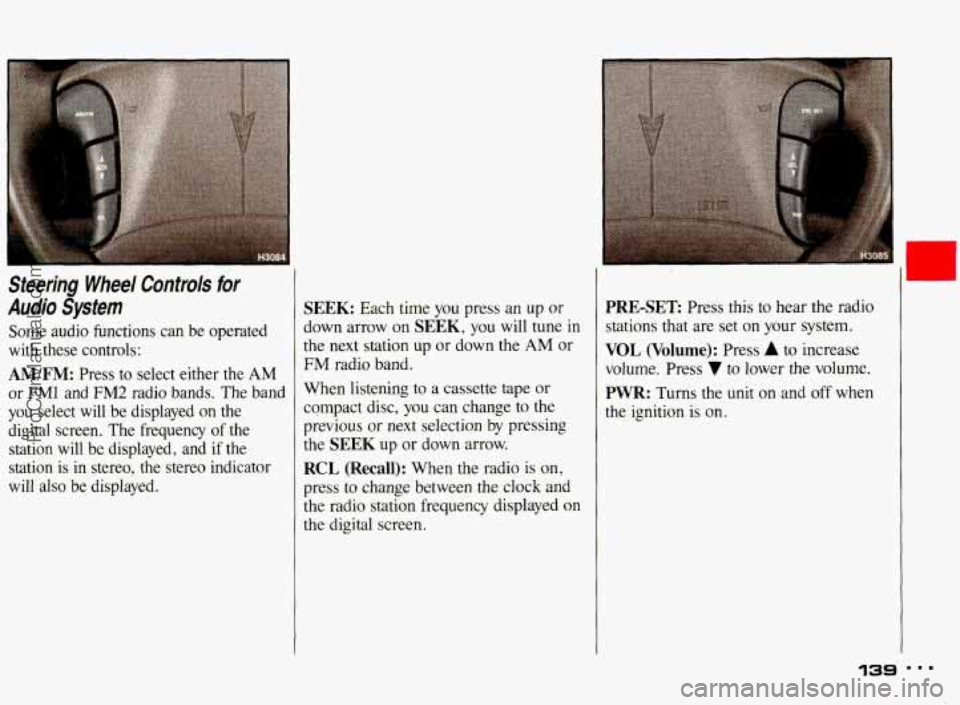
Steering Wheel Controls for
Audio System
Some audio functions can be operated
with these controls:
AM/FM: Press to select either the AM
or FMl and FM2 radio bands. The band
you select will
be displayed on the
digital screen. The frequency of the
station will be displayed, and
if the
station is in stereo, the stereo indicator
will also
be displayed.
SEEK: Each time you press an up or
down arrow on SEEK, you will tune in
the next station up or down the
AM or
FM radio band.
When listening
to a cassette tape or
compact disc, you can change to the
previous
or next selection by pressing
the
SEEK up or down arrow.
RCL (Recall): When the radio is on,
press
to change between the clock and
the radio station frequency displayed on
the digital screen.
I
PRE-SET Press this to hear the radio
stations that are set on your system.
VOL (Volume): Press A to increase
volume. Press
7 to lower the volume.
PWR: Turns the unit on and off when
the ignition is on.
139
t ProCarManuals.com
Page 157 of 322
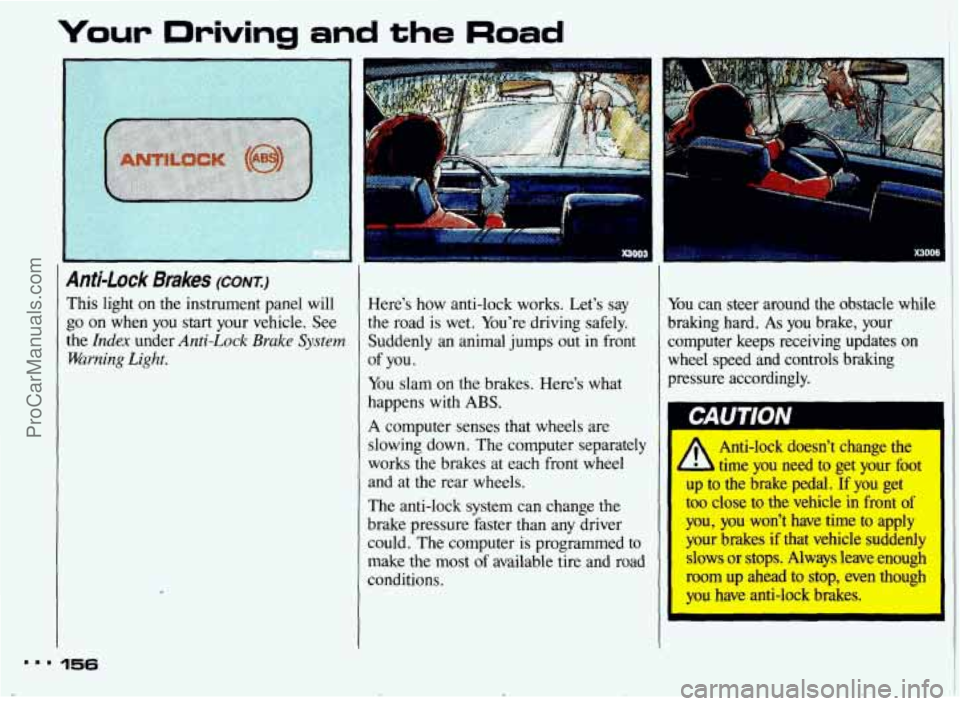
Your Driving and the Road
4nti-Lock Brakes (CONT.)
rhis light on the instrument panel will
;o on when you start your vehicle. See
he
Index under Anti-Lock Bruke System
iVarning Light.
-Iere's how anti-lock works. Let's say
he road is wet. You're driving safely.
Suddenly an animal jumps out in front
Y'ou slam on the brakes. Here's what
lappens with
ABS.
4 computer senses that wheels are
;lowing down. The computer separately
works the brakes at each front wheel
md at the rear wheels.
The anti-lock system can change the
)rake pressure faster than any driver
:ould.
The computer is programmed to
nake the most
of available tire and road
:onditions.
>f you.
'ou can steer around the obstacle while
raking hard.
As you brake, your
omputer keeps receiving updates on
{heel speed and controls braking
ressure accordingly.
1
A *,nti-lock doesn't change the
- --me you need to get your foot
up
to the brake pedal. If you get
too close to the vehicle
in front of
you, you won't have time to apply
your brakes
if that vehicle suddenly
slows
or stops. Always leave enough
room up ahead to
stop, even though
you have anti-lock brakes.
mmm 156
ProCarManuals.com
Page 161 of 322
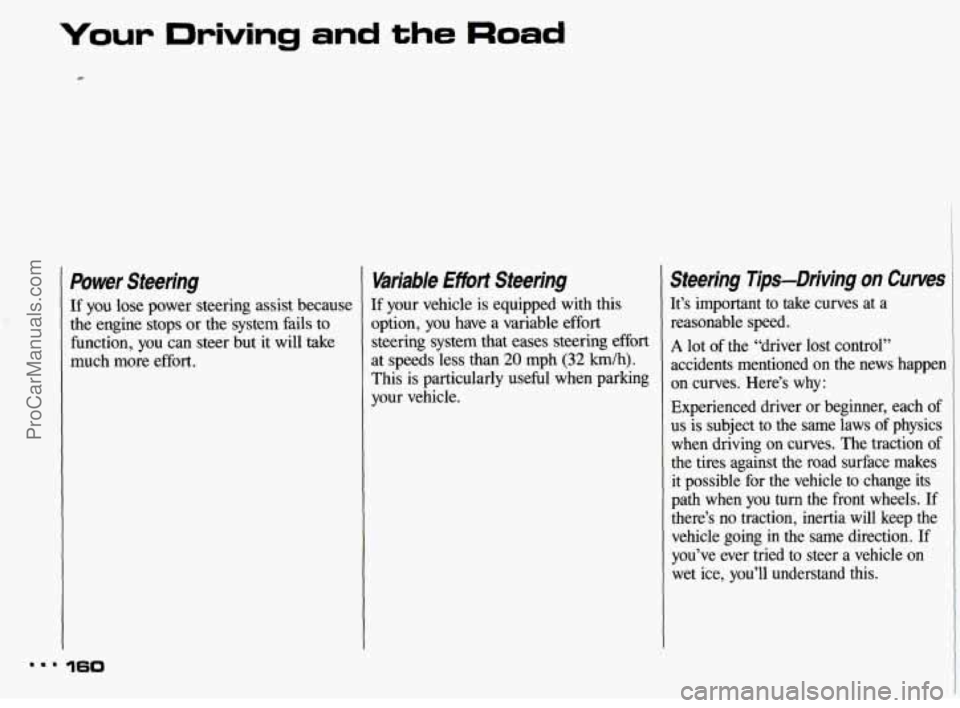
Your Driving and the Road
Power Steering
If you lose power steering assist because
the engine stops or the system fails to
function, you can steer but it will take
much more
effort.
Variable Effort Steering
If your vehicle is equipped with this
option, you have a variable effort
steering system that eases steering effort
at speeds less than
20 mph (32 Wh).
This is particularly useful when parking
your vehicle.
Steering Tips-Driving on Curves
It’s important to take curves at a reasonable speed.
A lot of the “driver lost control”
accidents mentioned on the news happen on curves. Here’s why:
Experienced driver or beginner, each of
us is subject to the same laws of physics
when driving on curves. The traction
of
the tires against the road surface makes
it possible for the vehicle to change
its
path when you turn the front wheels. If
there’s no traction, inertia will keep the vehicle going in the same direction.
If
you’ve ever tried to steer a vehicle on
wet ice, you’ll understand this.
mmm 160
ProCarManuals.com
Page 165 of 322

Your Driving and the Road
Passing (CONX:)
right lane to pass. When you are far
enough ahead of the passed vehicle to
see its front in your inside mirror,
activate your right lane change signal
and move back into the right lane.
(Remember that your right outside
mirror is convex. The vehicle you just
passed may seem to be farther away
from you than it really is.)
Try not to pass more than one vehicle
at a time on two-lane roads.
Reconsider before passing the next
vehicle.
vehicle too rapidly. Even though the
brake lights are not flashing,
it may be
slowing down or starting to
turn.
If you’re being passed, make it easy
for the following driver to get ahead
of
you. Perhaps you can ease a little to
the right.
Don’t overtake a slowly moving
Loss of Control
Let’s review what driving experts say
about what happens when the three
control systems (brakes, steering and
acceleration) don’t have enough friction
where the tires meet the road to do what
the driver has asked.
In any emergency, don’t give up. Keep
trying to steer and constantly seek
an
escape route or area of less danger.
Skidding
In a skid, a driver can lose control of
the vehicle. Defensive drivers avoid
most skids by taking reasonable care
suited to existing conditions, and by not
“overdriving” those conditions. But
skids are always possible.
The three types of skids correspond to
your Pontiac’s three control systems. In
the braking skid your wheels aren’t rolling. In the steering or cornering
skid, too much speed or steering in a
curve causes tires to slip and lose
cornering force. And in the acceleration
skid too much throttle causes the driving
wheels
to spin.
A cornering skid and an acceleration
skid are best handled by easing your
foot
off the accelerator pedal. If your
vehicle starts to slide (as when
you turn
ProCarManuals.com
Page 166 of 322
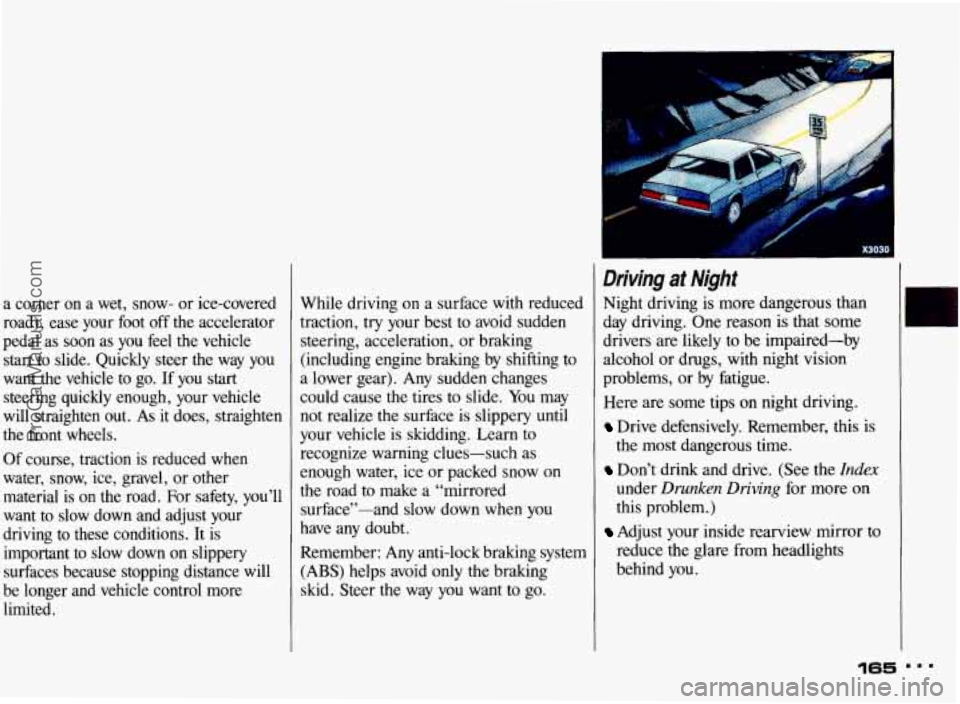
a corner on a wet, snow- or ice-covered
road), ease your foot off the accelerator
pedal as soon as you feel the vehicle
start to slide. Quickly steer the way you
want the vehicle to go. If you start
steering quickly enough, your vehicle
will straighten out. As it does, straighten
the front wheels.
Of course, traction is reduced when
water, snow, ice, gravel, or other
material is
on the road. For safety, you’ll
want to slow down and adjust your
driving to these conditions. It is
important to slow down on slippery
surfaces because stopping distance will
be longer and vehicle control more
limited. While
driving on a surface with reduced
traction, try your best
to avoid sudden
steering, acceleration, or braking
(including engine braking by shifting
to
a lower gear). Any sudden changes
could cause the tires to slide. You may
not realize the surface
is slippery until
your vehicle is skidding. Learn to
recognize warning clues-such as
enough water, ice
or packed snow on
the road to make a “mirrored
surface”-and slow down when
you
have any doubt.
Remember: Any anti-lock braking system
(ABS) helps avoid only the braking
slud. Steer the way you want to go.
Driving at Night
Night driving is more dangerous than
day driving. One reason is that some
drivers are likely to be impaired-by
alcohol or drugs, with night vision
problems, or by fatigue.
Here are some tips on night driving.
Drive defensively. Remember, this is
the most dangerous
time.
Don’t drink and drive. (See the Index
under Drunken Driving for more on
this problem.)
Adjust your inside rearview mirror to
reduce the glare from headlights
behind you.
165
ProCarManuals.com
Page 176 of 322
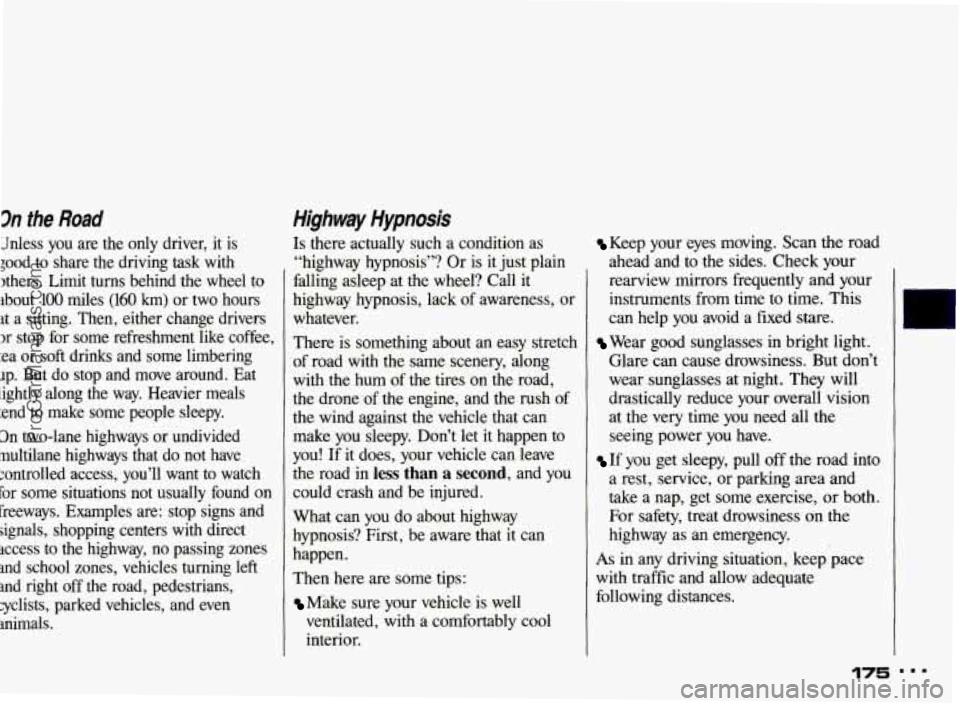
3n the Road
Mess you are the only driver, it is
;ood to share the driving task with
Ithers. Limit turns behind the wheel to
ibout 100 miles
(160 km) or two hours
it a sitting. Then, either change drivers
x stop for some refreshment like coffee,
:ea or
soft drinks and some limbering
lp. But do stop and move around. Eat
lightly along the way. Heavier meals
:end to make some people sleepy.
3n two-lane highways or undivided
multilane highways that do not have
;ontrolled access, you’ll want to watch for some situations not usually found on
freeways. Examples are: stop signs and
signals, shopping centers with direct
access to the highway, no passing zones
and school zones, vehicles turning left
and right off the road, pedestrians,
cyclists, parked vehicles, and even
animals.
Highway Hypnosis
Is there actually such a condition as
“highway hypnosis”? Or is it just plain
falling asleep at the wheel? Call it
highway hypnosis, lack
of awareness, o
whatever.
There is something about an easy stretch
of road with the same scenery, along
with the hum of the tires on the road,
the drone of the engine, and the rush of
the wind against the vehicle that can
make you sleepy. Don’t
let it happen to
you! If it does, your vehicle can leave
the road in
less than a second, and you
could crash and be injured.
What can you do about highway
hypnosis? First, be aware that it can
happen.
Then here are some tips:
Mike sure your vehicle is well
ventilated, with a comfortably cool interior.
Keep your eyes moving. Scan the road
ahead and to the sides. Check your
rearview mirrors frequently and your
instruments from time to time. This
can help you avoid a fixed stare.
Wear good sunglasses in bright light.
Glare can cause drowsiness. But don’t
wear sunglasses at night. They will
drastically reduce your overall vision
at the very time you need all the
seeing power
you have.
If you get sleepy, pull off the road into
a rest, service, or parking area and
take a nap, get some exercise, or both.
For safety, treat drowsiness on the
highway as an emergency.
As in any driving situation, keep pace
with traffic and allow adequate
following distances.
ProCarManuals.com